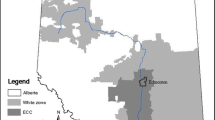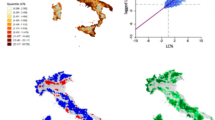Abstract
This article examines whether the pattern of urban land use should have been regulated by local government in the 1920s, the decade in which many cities adopted their first zoning ordinances. The study is based on the assumption that land values are influenced by the mix of land use on the block. Conditions for land-value maximization are derived, and the circumstances under which land-use zoning can increase land values are discussed. Empirical land-value and land-use functions are estimated for Chicago in 1921, two years before the first Chicago zoning ordinance was adopted. The empirical results for land values imply that the land-use zoning system adopted in 1923 could not have brought about a general increase in land values. The empirical results for land use document the regularities in the use of land prior to the introduction of zoning.
Similar content being viewed by others
References
“Amortization of Property Uses Not Conforming to Zoning Regulations.” (1942). University of Chicago Law Review 9, 477–496.
Babcock, R. (1957). “The Chicago Zoning Ordinance.” Northwestern University Law Review, 174–201.
Crone, T. (1983). “Elements of an Economic Justification for Municipal Zoning.” Journal of Urban Economics 14, 168–183.
Hoyt, H. (1933). One Hundred Years of Land Values in Chicago. Chicago: University of Chicago Press.
Library, City Planning and Zoning Committee of the Chicago Real Estate Board on Zoning in Chicago. (1923). Final Report. Chicago: Chicago Real Estate Board on Zoning in Chicago.
Maddala, G. (1983). Limited-Dependent and Qualitative Variables in Econometrics. Cambridge: Cambridge University Press.
McDonald, J. (1979). Economic Analysis of an Urban Housing Market. New York: Academic Press.
McDonald, J., and D. McMillen. (1990). “Employment Subcenters and Land Values in a Polycentric Urban Area: The Case of Chicago.” Environment and Planning 22, 1561–1574.
McMillen, D., and J. McDonald. (1991). “A Simultaneous Equations Model of Zoning and Land Values,” Regional Science and Urban Economics 21, 55–72.
McMillen, D., and J. McDonald, (1993). “Could Zoning Have Increased Land Values in Chicago?” Journal of Urban Economics 33, 167–188.
Mills, E. (1969). “The Value of Urban Land.” In H. Perloff (ed.), The Quality of the Urban Environment. Washington, DC: Resources for the Future.
Mills, E. (1979). “Economic Analysis of Urban Land-Use Controls.” In P. Mieszkowski and M. Straszheim (eds.), Current Issues in Urban Economics, Baltimore: Johns Hopkins University Press.
Olcott, G. (1922). Olcott's Land Values Blue Book of Chicago and Suburbs. Chicago: Olcott.
Yeates, M. (1965). “Some Factors Affecting the Spatial Distribution of Chicago Land Values.” Economic Geography 41, 57–70.
Author information
Authors and Affiliations
Rights and permissions
About this article
Cite this article
McDonald, J.F., McMillen, D.P. Land Values, Land Use, and the First Chicago Zoning Ordinance. The Journal of Real Estate Finance and Economics 16, 135–150 (1998). https://doi.org/10.1023/A:1007751616991
Issue Date:
DOI: https://doi.org/10.1023/A:1007751616991




